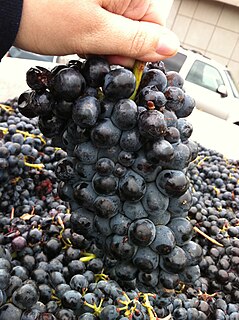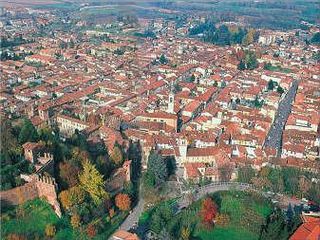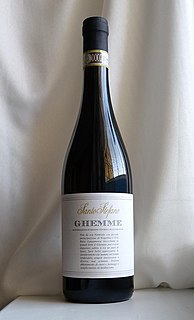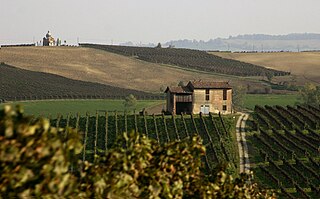
Nebbiolo is an Italian red wine grape variety predominantly associated with its native Piedmont region, where it makes the Denominazione di Origine Controllata e Garantita (DOCG) wines of Barolo, Barbaresco, Roero, Gattinara, Carema and Ghemme. Nebbiolo is thought to derive its name from the Italian nebbia or Piedmontese nebia, meaning "fog". During harvest, which generally takes place late in October, a deep, intense fog sets into the Langhe region where many Nebbiolo vineyards are located. Alternative explanations refers to the fog-like glaucous veil that forms over the berries as they reach maturity, or that perhaps the name is derived instead from the Italian word nobile, meaning noble. Nebbiolo produces lightly-colored red wines which can be highly tannic in youth with scents of tar and roses. As they age, the wines take on a characteristic brick-orange hue at the rim of the glass and mature to reveal other aromas and flavors such as violets, tar, wild herbs, cherries, raspberries, truffles, tobacco, and prunes. Nebbiolo wines can require years of aging to balance the tannins with other characteristics.

Barbera is a red Italian wine grape variety that, as of 2000, was the third most-planted red grape variety in Italy. It produces good yields and is known for deep color, full body, low tannins and high levels of acidity.

Novara is a province in the Piedmont region of Italy. Its capital is the city of Novara.

Italian wine is produced in every region of Italy, home to some of the oldest wine-producing regions in the world. Italy is the world's largest producer of wine, with an area of 702,000 hectares under vineyard cultivation, and contributing a 2013–2017 annual average of 48.3 million hl of wine. In 2018 Italy accounted for 19 percent of global production, ahead of France and Spain. Italian wine is both exported around the world and popular domestically among Italians, who consume an average of 42 litres per capita, ranking fifth in world wine consumption.

Sizzano is a comune (municipality) in the Province of Novara in the Italian region Piedmont, located about 80 kilometres (50 mi) northeast of Turin and about 20 kilometres (12 mi) northwest of Novara. As of 31 December 2004, it had a population of 1,452 and an area of 10.5 square kilometres (4.1 sq mi).

San Colombano al Lambro is a comune (municipality) in the Metropolitan City of Milan in the Italian region Lombardy, located about 40 kilometres (25 mi) southeast of Milan.
Freisa is a red Italian wine grape variety grown in the Piedmont region of north-west Italy, primarily in Monferrato and in the Langhe, but also further north in the provinces of Turin and Biella. Freisa is a vigorous and productive vine whose round, blue-black grapes are harvested in early October. The three-lobed leaves are relatively small and the bunches are elongated in form. By the 1880s it had become one of the major Piedmontese grapes, and in that period its cultivation was stimulated by the vine’s resistance to the downy mildew caused by the Plasmopara viticola fungus. Wines made from the Freisa grape are red and usually somewhat sweet and lightly sparkling, or foaming. Still and fully sparkling versions are also produced, however, as are dry and more decidedly sweet styles. In the Canavese there is also a rosé which can be made primarily from Freisa according to Denominazione di origine controllata (DOC) regulations.

Croatina is a red Italian wine grape variety that is grown primarily in the Oltrepò Pavese region of Lombardy and in the Province of Piacenza within Emilia Romagna, but also in parts of Piedmont and the Veneto. In the Oltrepò Pavese, in the hills of Piacenza, in Cisterna d’Asti and San Damiano d’Asti, and in Roero this variety is called ‘Bonarda’. It should not, however be confused with the Bonarda piemontese, which is an unrelated vine. In the Piedmont region, it is sometimes blended with Nebbiolo in the wines of Gattinara and Ghemme.
Cortese is a white Italian wine grape variety predominantly grown in the southeastern regions of Piedmont in the provinces of Alessandria and Asti. It is the primary grape of the Denominazione di origine controllata (DOC) wines of Cortese dell'Alto Monferrato and Colli Tortonesi as well as the Denominazione di Origine Controllata e Garantita (DOCG) wine of Cortese di Gavi. Significant plantings of Cortese can also be found in the Lombardy region of Oltrepò Pavese and in the DOC white blends of the Veneto wine region of Bianco di Custoza. Cortese has a long history in Italian viticulture with written documentation naming the grape among the plantings in a Piedmontese vineyard as early as 1659. The grape's moderate acidity and light flavors has made it a favorite for the restaurants in nearby Genoa as a wine pairing with the local seafood caught off the Ligurian coast.
Gattinara is a red Italian wine with Denominazione di Origine Controllata e Garantita (DOCG) status produced from Nebbiolo grapes grown within the boundaries of the comune of Gattinara which is located in the hills in the north of the province of Vercelli, northwest of Novara in the Piedmont region. It was awarded DOC status in 1967 and received its DOCG classification in 1990.

Piemonte wine is the range of Italian wines made in the region of Piedmont in the northwestern corner of Italy. The best-known wines from the region include Barolo and Barbaresco. They are made from the Nebbiolo grape. These wines are ideal for storage and a well-aged Barolo for instance may leave a feeling of drinking velvet because the tannins are polished and integrated more and more into the wine. As the wine matures the colour becomes more brownish and rust-red.

Lombardia (Lombardy) wine is the Italian wine produced in the Lombardy region of north central Italy. The region is known particularly for its sparkling wines made in the Franciacorta and Oltrepò Pavese areas. Lombardy also produces still red, white and rosé wines made from a variety of local and international grapes including Nebbiolo wines in the Valtellina region, Trebbiano di Lugana white wines produced with the Chiaretto style rosé along the shores of Lake Garda. The wine region currently has 15 Denominazione di origine controllata (DOC), 3 Denominazione di Origine Controllata e Garantita (DOCG) and 13 Indicazione Geografica Tipica (IGT) designations. The main cities of the region are Milan, Bergamo and Brescia. The region annually produces around 1.3 million hectolitres of wine, more than the regions of Friuli-Venezia Giulia, Marche, Trentino-Alto Adige/Südtirol and Umbria.

Arneis is a white Italian wine grape variety originating from Piedmont, Italy. It is most commonly found in the hills of the Roero, northwest of Alba, where it is part of the white Denominazione di Origine Controllata e Garantita (DOCG) wines of Roero. It can also be used to produce DOC wines in Langhe. Arneis is so called because it is regarded as a somewhat difficult variety to grow. It is a crisp and floral varietal, and has been grown for centuries in the region. The white wines made from the Arneis grape tend to be dry and full bodied with notes of pears and apricots.
Vespolina is a red Italian wine grape variety that is planted in Piedmont around Gattinara and Ghemme. Ampelographer believe that the grape is most likely indigenous to this area of Piedmont and recent DNA profiling identified a parent-offspring relationship with Nebbiolo. Outside Piedmont it is found in the Lombardy region of Oltrepò Pavese where the grape is known as Ughetta. In Gattinara, Vespolina is sometimes blended with Nebbiolo and Bonarda Piemontese. Unlike the white Italian grape Vespaiolo, the root of the name Vespolina does not have a direct connection with vespe or wasp. However the true origins of the name are still unclear.

Ghemme is a red Italian wine with Denominazione di Origine Controllata e Garantita status produced in the Colli Novaresi viticultural area in the hills of the Province of Novara in Piedmont. It was awarded DOC status in 1969 and received its DOCG classification in 1997.

The Colli Piacentini is an Italian wine region located at the western end of Emilia-Romagna. In 1967, it was given the Denominazione di origine controllata (DOC) quality designation. Within its boundaries are several smaller DOCs including Colli Piacentini Gutturnio, Monterosso Val D'Arda DOC, Trebbianino Val Trebbia DOC and Val Nur del Colli Piacentini DOC. The region has a long history of winemaking with fossilized vine roots and grape seeds excavated from the region showing viticulture taking place as early as 2000 BC. In Roman times, Julius Caesar's father-in-law Lucius Calpurnius Piso Caesoninus, grew grapes in the Piacenza hills.
Rossola nera is a red Italian wine grape variety that has been growing in the Valtellina region of Lombardy since at least the 17th century. In 2004 DNA profiling determined that the grape has a parent-offspring relationship with the Piedmont wine grape Nebbiolo though which variety is the parent and which is the offspring is not yet clear. However, most ampelographers believe that Nebbiolo is likely the parent variety since written records in Piedmont have noted Nebbiolo being grown since at least the 13th century.
Avanà is a red Italian wine grape variety that is grown in the Piedmont wine region of northwest Italy. Historically, the grape has also been grown in the Dauphiné and Savoie wine region of eastern France where it was known as Hibou noir and in the Valais region of Switzerland. The grape is most often used as a blending variety in the Denominazione di origine controllata (DOC) zones of Pinerolese, with Barbera, Persan, Freisa and Neretta Cuneese, and Valsusa, with Barbera, Dolcetto, Neretta Cuneese and other local red Piemontese varieties.
Avarengo is a red Italian wine grape variety that is grown in the Piedmont wine region of northwest Italy where it is a permitted blending component in the Denominazione di origine controllata (DOC) wines of Pinerolese. Here the grape is usually blended with Avanà, Neretta Cuneese and other local red Piemontese varieties.
Barbera del Sannio is a red Italian wine grape variety that is grown in the Campania region of southern Italy. Despite the similarities in name and appearance, the grape has no close genetic relationship with the Piedmont wine grapes Barbera or Barbera bianca or the Sardinian wine grape Barbera Sarda and is, instead, more closely related to the Campanian varieties Casavecchia and Catalanesca and the Apulian grape Nero di Troia.













